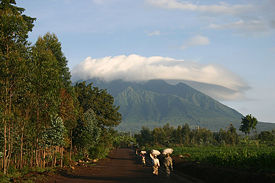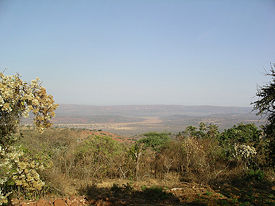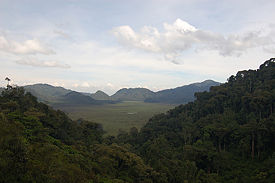National parks of Rwanda
Rwanda is a small landlocked country in the Great Lakes region of east-central Africa. Its hilly terrain, which gives it the title "Land of a Thousand Hills," supports the densest population in sub-Saharan Africa. The country has a mostly mountainous landscape that includes the volcanic Virunga range in the northwest, home to what is estimated to be half of the world’s remaining mountain gorillas. Its once extensive forests are now concentrated in the western mountains and the Nyungwe forest, near Lake Kivu.
In 1978, the Wildlife Conservation Society began working in the nation, supporting studies of mountain gorilla ecology and the socio-economic context for conservation. From this sprang a program of mountain gorilla tourism which not only generates revenue and employment, but also helps protect the gorillas and their habitat. In the mid-1980s the organization expanded its focus to the Nyungwe Forest. The largest known mid-altitude forest of Africa, the area became a national park in 2004. [1]
Rwanda has three National parks: the Akagera, the Nyungwe Forest, and the Volcanoes, which were created in the spirit of conservation and preservation of the natural environment.
Akagera National Park
The Akagera National Park (French: Parc National de l'Akagera) covers 2,500km² in north eastern Rwanda, against the Tanzanian border. It was founded in 1934 to protect animals in three ecoregions: savannah, mountain and swamp. It includes lakes including Lake Shakani and Lake Ihema.
Much of the savannah area of the park was settled in the late 1990s by former refugees returning after the end of the Rwandan Civil War, but the other regions remain relatively remote. Animals which fled during the upheavals are now returning. The park is named for the Kagera River which flows through it.
Nyungwe Forest National
Nyungwe Forest National Park is a national park in southwestern Rwanda, located south of Lake Kivu on the border with Burundi. The park was established in 2004 and covers an area of approximately 970 km² of rainforest, bamboo, grassland, swamps, and bogs. The nearest town is Cyangugu, 54 km to the west. Mount Bigugu is located within the park borders.
Animal life
Nyungwe has a wide diversity of animal species, making it a priority for conservation in Africa. The forest is situated in a region where several large-scale biogeographical zones meet and the variety of terrestrial biomes provide a great span of microhabitats for many different species of plants and animals.
The park contains 13 different primate species (25% of Africa's total), 275 bird species, 1068 plant species, 85 mammal species, 32 amphibian and 38 reptile species. Many of these animals are restricted-range species that are only found in the Albertine Rift ecoregion in Africa. In fact, the number of endemic species found here is greater than in any other forest in the Albertine Rift that has been surveyed.
Primate species
- Common Chimpanzee (Pan troglodytes)
- Adolf Friedrich's Angola Colobus (Colobus angolensis ruwenzori)
- L'Hoest's Monkey (Cercopithecus l'hoesti)
- Silver Monkey (Cercopithecus doggetti)
- Golden Monkey (Cercopithecus kandti)
- Hamlyn's Monkey (Cercopithecus hamlyni)
- Red-tailed Monkey (Cercopithecus ascanius)
- Dent's Mona Monkey (Cercopithecus denti)
- Vervet Monkey (Chlorocebus pygerythrus)
- Olive Baboon (Papio anubis)
- Grey-cheeked Mangabey (Lophocebus albigena)
Notes
- ↑ Wildlife Conservation Society. Saving Wildlife - Rwanda Retrieved May 8, 2008.
ReferencesISBN links support NWE through referral fees
- Nyungwe National Park. Wildlife Conservation Society. Retrieved 2006-05-25.
- Nyungwe National Park, Rwanda. NASA Earth Observatory. Retrieved 2006-05-25.
- Vande weghe, Jean Pierre: Akagera: Land of water, grass and fire / Jean Pierre Vande weghe. With collaboration of Thérèse Abandibakobwa, José Kalpers a.o. Photography by Philippe Dejace. Translated by Alicia L. Spruijt-Ray. - Brussels: World Wildlife Fund for Nature, 1990
External links
- The Rwanda Tourist Board (ORTPN)
- Volcanoes National Park at UN Environment Programme World Conservation Monitoring Centre
- The Virunga Primates page from Footprint Adventures
- Rwanda National ParksFind all information about Rwanda's safari parks and wildlife.
- World Conservation Society
Credits
New World Encyclopedia writers and editors rewrote and completed the Wikipedia article in accordance with New World Encyclopedia standards. This article abides by terms of the Creative Commons CC-by-sa 3.0 License (CC-by-sa), which may be used and disseminated with proper attribution. Credit is due under the terms of this license that can reference both the New World Encyclopedia contributors and the selfless volunteer contributors of the Wikimedia Foundation. To cite this article click here for a list of acceptable citing formats.The history of earlier contributions by wikipedians is accessible to researchers here:
The history of this article since it was imported to New World Encyclopedia:
Note: Some restrictions may apply to use of individual images which are separately licensed.


